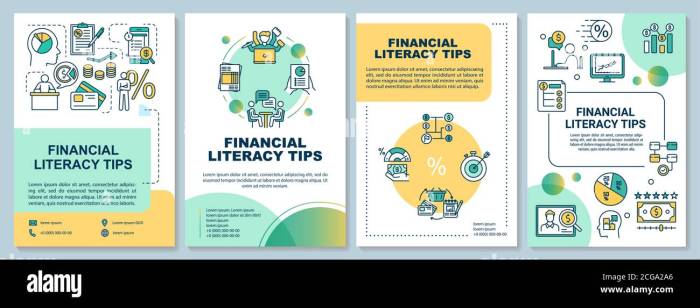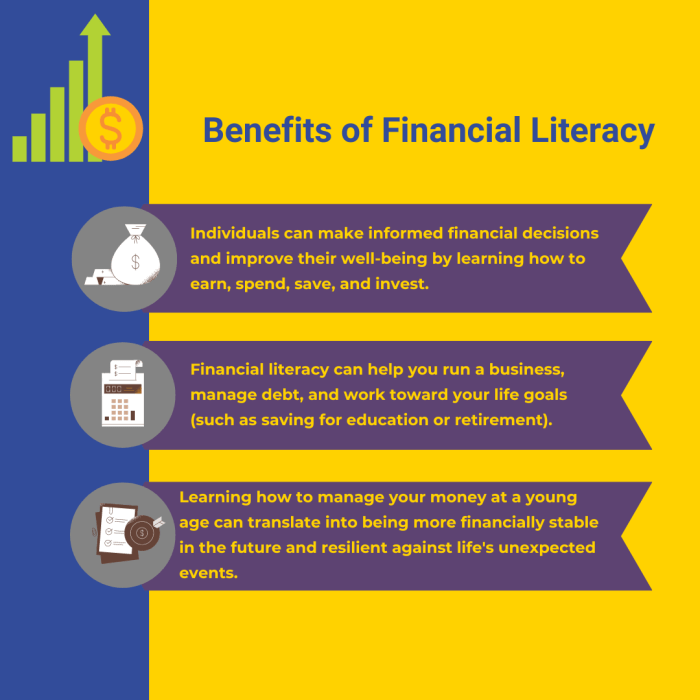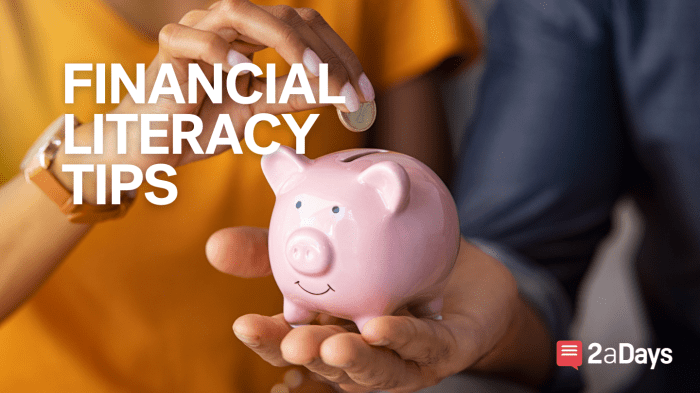Financial Literacy Tips Guide: Embark on a hilarious yet informative journey to financial freedom! Forget boring lectures; we’re diving headfirst into the wild world of budgeting, investing, and debt management – all while keeping it refreshingly relatable. Prepare for witty explanations, surprising insights, and enough practical advice to make your wallet sing (a happy song, of course).
This guide tackles everything from mastering the art of budgeting (yes, even on a ramen noodle diet) to navigating the treacherous waters of debt and investing. We’ll demystify credit scores, help you set SMART financial goals (that you’ll actually stick to!), and even offer tips on protecting yourself from those sneaky financial scams. Get ready to laugh, learn, and level up your financial game.
Budgeting Basics
Ah, budgeting. The word itself might conjure images of dreary spreadsheets and soul-crushing limitations. But fear not, dear reader! Budgeting is less about deprivation and more about empowered financial decision-making. Think of it as a financial GPS, guiding you towards your money goals instead of letting your spending wander aimlessly. Let’s navigate this together, shall we?
Mastering budgeting is crucial for achieving financial stability and even wealth. It’s about understanding where your money goes and consciously deciding where it should go. Without a budget, your money is like a ship without a rudder, susceptible to the whims of impulse purchases and unexpected expenses.
The 50/30/20 Budgeting Rule
This popular rule of thumb divides your after-tax income into three categories: 50% for needs, 30% for wants, and 20% for savings and debt repayment. It’s a simple yet effective framework, especially for beginners. Let’s illustrate with examples:
Example 1: $3,000 Monthly Income
Needs (50%): $1,500 (Rent/Mortgage, Groceries, Utilities, Transportation)
Wants (30%): $900 (Dining Out, Entertainment, Hobbies)
Savings & Debt (20%): $600 (Emergency Fund, Retirement Contributions, Loan Payments)
Example 2: $6,000 Monthly Income
Needs (50%): $3,000 (Higher rent, potentially a car payment, premium groceries)
Wants (30%): $1,800 (More frequent dining out, higher-end entertainment)
Savings & Debt (20%): $1,200 (Larger contributions to retirement, faster debt repayment)
Different Budgeting Methods
Several methods can help you stick to your budget. The best one depends on your personality and preferences.
Envelope System: Allocate cash to different categories (groceries, entertainment, etc.) and place it in separate envelopes. Once the cash is gone, that’s it! This method emphasizes physical limitations and can be very effective for visual learners.
Zero-Based Budgeting: Assign every dollar of your income to a specific expense category, ensuring your income minus expenses equals zero. This approach promotes mindful spending and prevents unexpected shortfalls. It requires more meticulous tracking than the envelope system but offers a detailed picture of your finances.
Software and Apps: Numerous budgeting apps and software programs automate tracking, categorize expenses, and provide insightful reports. Mint, YNAB (You Need A Budget), and Personal Capital are popular examples. These tools offer convenience and powerful analysis features, but they require digital literacy and trust in the technology.
Sample Monthly Budget
Below is a sample monthly budget. Remember, your categories and amounts will vary based on your individual circumstances.
| Income | Expenses | Category | Remaining Balance |
|---|---|---|---|
| $4,000 | $1,000 | Housing | $3,000 |
| $500 | Groceries | $2,500 | |
| $200 | Transportation | $2,300 | |
| $100 | Utilities | $2,200 | |
| $300 | Entertainment | $1,900 | |
| $800 | Savings | $1,100 | |
| $100 | Debt Payments | $1,000 | |
| $100 | Miscellaneous | $900 |
Saving & Investing

Saving and investing: the dynamic duo of financial freedom. Think of it like this: saving is building a sturdy castle (your emergency fund), while investing is constructing a sprawling kingdom (your long-term wealth). One protects you from the dragons of unexpected expenses, the other paves the way for a financially comfortable future. Neglecting either is akin to building a castle on sand – beautiful, but ultimately unsustainable.
Building an emergency fund is the cornerstone of responsible financial planning. It’s your safety net, your financial parachute, your “I-spilled-coffee-all-over-my-new-suit” fund. Without it, a sudden job loss or unexpected car repair can send your finances into a tailspin. Aim for 3-6 months’ worth of living expenses; this number provides a comfortable buffer against life’s little (and big) surprises. For example, if your monthly expenses are $3,000, you should strive to save between $9,000 and $18,000. This might seem daunting, but remember, even small, consistent contributions add up over time.
Emergency Fund Strategies
Saving for an emergency fund requires discipline and a clear plan. Start by tracking your expenses to identify areas where you can cut back. Then, automate your savings – set up automatic transfers from your checking account to your savings account each month. Consider high-yield savings accounts to maximize your interest earnings. Think of it as your money working for you, even while you’re sleeping! Another effective strategy is to allocate a portion of any unexpected income, like a bonus or tax refund, directly to your emergency fund. This accelerated approach can significantly shorten the time it takes to reach your savings goal.
Investment Options
Investing your money allows your capital to grow over time, potentially outpacing inflation and building long-term wealth. Several options exist, each with its own risk-return profile. Stocks represent ownership in a company, offering high potential returns but also higher volatility. Bonds are loans you make to a company or government, generally considered less risky than stocks but with lower potential returns. Mutual funds pool money from multiple investors to invest in a diversified portfolio of stocks, bonds, or other assets, offering diversification and professional management. Real estate involves investing in properties, providing potential rental income and long-term appreciation but requiring significant capital and management.
Understanding Risk and Return
The relationship between risk and return is fundamental to investing. Higher potential returns generally come with higher risk. Stocks, for instance, can experience significant price fluctuations, while bonds tend to be more stable. Diversification, spreading your investments across different asset classes, is a key strategy to mitigate risk. A well-diversified portfolio reduces the impact of any single investment performing poorly. Consider your risk tolerance – your comfort level with potential losses – when choosing your investments. A younger investor with a longer time horizon might be more comfortable taking on higher risk for potentially greater returns.
Opening a Brokerage Account and Making Your First Investment, Financial Literacy Tips Guide
Opening a brokerage account is the first step to investing. You’ll need to choose a brokerage firm, provide personal information, and fund your account. Most brokerages offer user-friendly online platforms. Once your account is funded, you can research investment options and place your first trade. Remember to start small and gradually increase your investment amount as you gain experience and confidence. Consider consulting a financial advisor for personalized guidance, especially if you are new to investing. Before making any investment decisions, thoroughly research the companies or funds you’re considering and understand the associated risks.
Debt Management

Ah, debt. That delightful financial companion that whispers sweet nothings of instant gratification while simultaneously plotting your long-term financial demise. But fear not, intrepid financial adventurer! Mastering debt management isn’t about becoming a hermit; it’s about becoming a savvy strategist in the thrilling game of personal finance. This section will equip you with the tools to navigate the treacherous terrain of debt and emerge victorious.
Debt comes in many forms, each with its own unique personality and quirks. Understanding these personalities is the first step to taming them.
Types of Debt and Management Strategies
Let’s examine the common types of debt and discuss effective strategies for managing each. Think of it as a monster-taming guide, but instead of fire-breathing dragons, we’re dealing with credit card bills, student loans, and mortgages.
- Credit Card Debt: This is often the most immediate and potentially volatile type of debt. High interest rates can quickly snowball your balance, making it feel like you’re running on a financial treadmill. The best strategy? Pay more than the minimum payment, aggressively chipping away at the principal. Consider transferring balances to a card with a lower interest rate (but be mindful of balance transfer fees!). Avoid further charges whenever possible – treat your credit card like a debit card with strict spending limits.
- Student Loans: These are often long-term debts, but understanding your repayment options is crucial. Federal student loans offer various repayment plans, including income-driven repayment plans that adjust your monthly payments based on your income. Explore these options carefully to find the best fit for your financial situation. For private student loans, actively negotiate with your lender to see if they can offer a more manageable repayment plan or a lower interest rate.
- Mortgages: While mortgages are generally considered “good debt” (because they help you build equity), managing them effectively is still vital. Make your mortgage payments on time to avoid late fees and potential damage to your credit score. Consider making extra principal payments to reduce the overall interest paid and shorten the loan term. Refinancing might be an option if interest rates drop significantly.
Debt Repayment Plans: Snowball vs. Avalanche
Once you’ve identified your debts, it’s time to develop a repayment plan. Two popular methods are the snowball and avalanche methods. Think of these as two different approaches to conquering a mountain of debt.
- Snowball Method: This method focuses on paying off the smallest debt first, regardless of its interest rate. The psychological boost of quickly eliminating a debt can provide motivation to continue tackling the larger ones. Imagine the satisfying feeling of crossing off a debt from your list!
- Avalanche Method: This method prioritizes paying off the debt with the highest interest rate first, regardless of its size. This approach minimizes the total amount of interest paid over the long run, saving you money in the long term. This is the mathematically superior method but can lack the initial motivational boost of the snowball method.
Debt Consolidation Options
Debt consolidation involves combining multiple debts into a single loan. This can simplify repayment and potentially lower your monthly payments or interest rate. However, it’s not a magic bullet, and careful consideration is necessary.
| Consolidation Method | Pros | Cons |
|---|---|---|
| Balance Transfer Credit Card | Lower interest rate (initially), simplified payments | Balance transfer fees, potential for higher rates after introductory period, risk of overspending |
| Personal Loan | Fixed interest rate, predictable monthly payments, potential for lower interest rate than credit cards | Requires good credit, fees may apply, may not cover all debts |
| Debt Management Plan (DMP) | Lower interest rates, single monthly payment, credit counseling | Negative impact on credit score, fees may apply |
Understanding Credit Scores

Your credit score: that three-digit number that holds more power than a superhero’s cape (okay, maybe not *that* much power, but it’s pretty significant). It’s the key to unlocking favorable interest rates on loans, credit cards, and even sometimes apartments. Understanding how it works is crucial to achieving your financial goals, and avoiding the pitfalls of high-interest debt. Let’s delve into the fascinating world of credit scores.
Credit scores are calculated using a complex formula, but the main ingredients are pretty straightforward. Lenders use these scores to assess your creditworthiness – essentially, how likely you are to repay your debts. A higher score means you’re viewed as a lower risk, resulting in better loan terms. A lower score? Well, let’s just say it can make borrowing money a much more expensive proposition.
Factors Influencing Credit Scores and Their Impact on Borrowing Rates
Several key factors significantly impact your credit score, and subsequently, your borrowing rates. These factors are weighted differently by different credit scoring models (like FICO and VantageScore), but the core components remain consistent. Understanding these factors empowers you to make informed financial decisions and improve your score.
A significant factor is your payment history. Late or missed payments are like a flashing neon sign screaming “risk!” to lenders. They severely damage your credit score, leading to higher interest rates on future loans. Conversely, a history of on-time payments is a credit score gold star.
Another crucial factor is your amounts owed, often expressed as your credit utilization ratio. This ratio compares the amount of credit you’re using to your total available credit. Keeping this ratio low (ideally below 30%) shows lenders you’re managing your debt responsibly. Maxing out your credit cards is a major credit score no-no.
The length of your credit history also matters. A longer history of responsible credit use demonstrates a proven track record of reliability. This is why it’s important to establish credit early in life, even if it’s just with a secured credit card.
The types of credit you use also play a role. Having a mix of credit accounts (like credit cards and installment loans) can be beneficial, but excessive borrowing across multiple accounts can negatively impact your score.
Finally, new credit inquiries can temporarily lower your score. Each time you apply for new credit, it shows up on your report, indicating potential risk. Avoid applying for multiple loans or credit cards within a short period.
Improving Your Credit Score
Improving your credit score is achievable with consistent effort and mindful financial habits. It’s a marathon, not a sprint, so be patient and persistent.
Paying bills on time is the cornerstone of a good credit score. Set up automatic payments to avoid accidental late payments. This single action can dramatically improve your credit health.
Maintaining a low credit utilization ratio is another crucial step. Avoid maxing out your credit cards, and strive to keep your utilization ratio below 30%. Paying down your balances regularly will help you achieve this.
Dispute any errors on your credit report. Errors happen, and they can significantly impact your score. Regularly checking your credit report for inaccuracies is essential.
Obtaining a Free Credit Report and Identifying Potential Errors
You’re entitled to a free credit report from each of the three major credit bureaus (Equifax, Experian, and TransUnion) annually through AnnualCreditReport.com. This is the only official website authorized to provide free credit reports; beware of scams.
Reviewing your credit report meticulously is crucial. Look for any inconsistencies or errors. If you find anything inaccurate, dispute it immediately with the relevant credit bureau. Provide supporting documentation to back up your claim. This could involve bank statements or other evidence proving the error. Remember, a clean credit report is a happy credit report.
Financial Goal Setting: Financial Literacy Tips Guide

Let’s face it, money isn’t exactly known for its exciting personality. But setting financial goals? That’s where the fun begins! Think of it as a treasure hunt, except instead of X marking the spot, it’s your dream vacation, a down payment on a house, or even early retirement sipping margaritas on a beach (with a very healthy savings account, of course). Setting clear goals is the first step towards achieving financial freedom – and avoiding the dreaded “financial hangover” later on.
Setting financial goals isn’t about deprivation; it’s about strategic planning for a richer, more fulfilling life. It’s about aligning your spending with your aspirations, making your money work *for* you, rather than the other way around. We’ll explore a proven framework to help you define and conquer your financial aspirations.
SMART Financial Goal Template
The SMART framework provides a structured approach to goal setting, ensuring your goals are clear, measurable, and attainable. It’s the financial equivalent of a well-oiled machine – efficient and effective. This template helps avoid vague aspirations and ensures you have a roadmap to success.
| SMART Goal Element | Description | Example (Short-Term) | Example (Long-Term) |
|---|---|---|---|
| Specific | Clearly define what you want to achieve. | Save $1,000 for a new laptop. | Save $100,000 for a down payment on a house. |
| Measurable | Establish quantifiable metrics to track progress. | Track savings through a dedicated savings account and spreadsheet. | Track savings progress using a dedicated investment account and financial planning software. |
| Achievable | Ensure the goal is realistic given your current resources and timeframe. | Save $200 per month for 5 months. | Save $500 per month for 16 years and 8 months, while also investing. |
| Relevant | Ensure the goal aligns with your overall financial objectives and life priorities. | This goal directly supports my need for a reliable laptop for work. | This goal directly supports my long-term goal of homeownership. |
| Time-Bound | Set a deadline for achieving the goal. | Save $1,000 by December 31st, 2024. | Save $100,000 by December 31st, 2038. |
Examples of Short-Term and Long-Term Financial Goals
Short-term goals provide quick wins and build momentum. Think of them as the appetizers before the main course of your long-term financial strategy. Long-term goals are the main course – the big picture achievements that require sustained effort and planning.
Short-Term Goals (typically achieved within 1 year):
- Emergency fund of 3-6 months’ living expenses.
- Paying off a small debt (credit card, medical bill).
- Saving for a vacation.
- Buying a new appliance.
Long-Term Goals (typically achieved over 5+ years):
- Retirement planning (401k, IRA contributions).
- Down payment on a house or condo.
- Funding a child’s education.
- Starting a business.
Strategies for Staying Motivated and Tracking Progress
Maintaining motivation and tracking progress are crucial for success. It’s like training for a marathon; you need a plan, regular check-ins, and the right support system to stay on track. Here are some effective strategies to keep you motivated and on the path to achieving your financial goals.
Staying motivated and tracking progress requires consistent effort and a proactive approach. Think of it as a game with rewards along the way. Regular monitoring prevents you from straying off course and allows for necessary adjustments.
- Visualize your success: Create a vision board or regularly review your goals to stay focused.
- Break down large goals into smaller, manageable steps: This makes the process less daunting and provides a sense of accomplishment along the way.
- Reward yourself for milestones achieved: Celebrate your successes, but keep the rewards aligned with your overall financial plan.
- Track your progress regularly: Use budgeting apps, spreadsheets, or financial planning software to monitor your progress.
- Seek support and accountability: Share your goals with a friend, family member, or financial advisor for support and encouragement.
- Adjust your plan as needed: Life happens! Be flexible and adjust your goals as your circumstances change.
Protecting Your Finances

Let’s face it, money worries can be a real drag on your happiness. While we’ve covered making money and managing it, this section is all about safeguarding what you’ve worked so hard to accumulate. Think of it as building a financial fortress – strong, resilient, and annoyingly difficult for trouble to penetrate.
Protecting your financial well-being isn’t just about avoiding scams; it’s about proactively shielding yourself from life’s unexpected punches. From the minor (a cracked phone screen) to the major (a catastrophic illness), life throws curveballs. Proper planning minimizes the financial fallout.
Insurance: Your Financial Safety Net
Insurance is like having a superhero sidekick for your finances. Different types of insurance protect against various risks, preventing a single unfortunate event from wiping out years of careful saving. Health insurance protects against crippling medical bills, auto insurance covers accidents and repairs, home insurance safeguards your property from damage, and life insurance provides financial security for your loved ones should the unexpected occur. Consider your specific needs and risk tolerance when choosing coverage levels. For example, a young, healthy individual might opt for a more basic health plan, while someone with pre-existing conditions may require more comprehensive coverage. Similarly, homeowners in hurricane-prone areas need higher levels of coverage than those in less risky locations.
Wills and Power of Attorney: Planning for the Future
Nobody likes thinking about their mortality, but having a will is crucial for ensuring your assets are distributed according to your wishes after you’re gone. Without a will, the state decides how your property is divided, which might not align with your intentions. A will allows you to designate guardians for minor children and clearly Artikel how your assets will be handled, saving your loved ones considerable stress and potential legal battles. Similarly, a power of attorney allows you to appoint someone you trust to manage your finances and make decisions on your behalf if you become incapacitated. Imagine needing urgent medical care but being unable to authorize treatment or access your funds – a power of attorney prevents such a scenario.
Avoiding Financial Scams and Identity Theft
Financial scams are, unfortunately, as common as pigeons in a city square. They prey on our trust and vulnerabilities. Be wary of unsolicited calls, emails, or texts promising quick riches or demanding immediate payment. Never share personal information like your social security number, bank account details, or credit card information unless you’re absolutely certain of the recipient’s legitimacy. Regularly monitor your bank and credit card statements for any unauthorized activity, and consider using credit monitoring services to catch potential identity theft early. Remember, if something sounds too good to be true, it probably is. For example, be wary of emails promising large sums of money from unknown sources or investment opportunities with guaranteed high returns – these are often hallmarks of scams. A legitimate investment always carries some degree of risk.
Tax Basics
Let’s face it, taxes aren’t exactly a party. But understanding the basics can save you a headache (and maybe even some money!). This section will demystify the world of taxation, turning it from a confusing monster into a manageable beast. We’ll explore different tax types, strategies for minimizing your tax burden legally, and even walk through the filing process. Prepare for a surprisingly fun (yes, really!) journey into the land of tax.
Types of Taxes
Taxes are the price we pay for a civilized society – think of it as a membership fee for living in a country with roads, schools, and a surprisingly efficient postal service (most of the time). There are several main types of taxes, each with its own unique quirks and charms.
Income Tax: This is the tax levied on your earnings – salaries, wages, investment income, and even those surprisingly lucrative side hustles. The amount you pay depends on your income bracket, with higher earners generally paying a higher percentage. Think of it as a progressive tax system: the more you earn, the more you contribute to the collective pot (but hopefully you also have more to enjoy after paying your fair share!).
Sales Tax: This is a tax added to the price of goods and services you buy. The rate varies by state and even by locality, making it a bit of a geographical adventure. Imagine it as a small surcharge for the privilege of acquiring that new pair of shoes or that ridiculously oversized coffee. You’ll pay it when you buy almost everything!
Property Tax: This tax is levied on the value of your property, whether it’s your house, apartment, or even that tiny plot of land you bought with the intention of building a treehouse (but haven’t yet). The amount you pay depends on the assessed value of your property and the local tax rate. Consider it your contribution towards maintaining local infrastructure and services like schools and fire departments – the unsung heroes of our communities.
Strategies for Minimizing Tax Liability
Now for the fun part: legally reducing your tax bill! Remember, we’re talking about *legal* and *ethical* strategies. Avoid anything that smells remotely like tax evasion – that’s a path to a whole lot of trouble.
Maximize Deductions and Credits: Explore various deductions and tax credits available to you. These are essentially ways the government gives you a break on your taxes. Common deductions might include charitable donations, mortgage interest, or contributions to retirement accounts. Tax credits directly reduce the amount of tax you owe, offering even more savings.
Retirement Planning: Contributing to tax-advantaged retirement accounts like 401(k)s and IRAs can lower your taxable income in the present. This is a win-win: you save for retirement and reduce your current tax liability. It’s like getting a discount on your future self’s financial security!
Proper Tax Planning: Consult a tax professional (or at least utilize reputable online resources) for personalized advice. They can help you navigate the complexities of tax laws and find strategies tailored to your specific financial situation. Think of them as your personal tax sherpas, guiding you through the sometimes-treacherous terrain of tax regulations.
Tax Filing Process
The tax filing process might seem daunting, but breaking it down makes it much more manageable. Think of it as a structured puzzle, and you’ll be solving it in no time.
| Step | Action | Timeline | Tip |
|---|---|---|---|
| 1. Gather Documents | Collect all necessary tax documents, including W-2s, 1099s, and receipts for deductible expenses. | Throughout the year | Organize your documents in a dedicated folder or using a digital filing system. |
| 2. Choose a Filing Method | Decide whether to file electronically or by mail. Electronic filing is generally faster and more efficient. | Before the deadline | Consider using tax software to simplify the process. |
| 3. Complete Tax Return | Fill out the appropriate tax forms accurately and completely. | Several weeks before the deadline | Double-check all information for accuracy before submitting. |
| 4. File and Pay | Submit your tax return and pay any taxes owed by the deadline. | By the tax deadline (typically April 15th) | File early to avoid last-minute stress. |
Retirement Planning

Retirement: the golden years, the time for leisurely pursuits, the era of finally figuring out what a “leisure suit” actually *is*. But achieving this blissful state requires more than just hoping for the best; it necessitates a well-thought-out retirement plan. Let’s dive into the options and strategies that can help you secure a comfortable and enjoyable retirement, avoiding the dreaded “retirement regret” that can haunt those who didn’t plan ahead.
Retirement savings options aren’t a one-size-fits-all affair. Choosing the right plan depends on your individual circumstances, risk tolerance, and financial goals. Understanding the nuances of each option is crucial to making an informed decision.
401(k) Plans
A 401(k) is a retirement savings plan sponsored by your employer. Contributions are often tax-deferred, meaning you don’t pay taxes on the money until you withdraw it in retirement. Many employers offer matching contributions, essentially giving you free money! However, contributions are limited by annual IRS guidelines, and your investment options are typically limited to those offered by your employer. The potential for employer matching contributions is a significant advantage, boosting your savings substantially. Consider it a little nudge from your employer to secure your financial future.
Individual Retirement Accounts (IRAs)
IRAs offer more flexibility than 401(k)s. There are two main types: Traditional and Roth. A Traditional IRA allows for tax-deductible contributions, lowering your current taxable income. However, withdrawals in retirement are taxed. A Roth IRA, conversely, involves contributions made with after-tax dollars, but withdrawals in retirement are tax-free. The choice depends on your current and projected future tax brackets. If you expect to be in a higher tax bracket in retirement, a Roth IRA might be preferable; if you anticipate a lower tax bracket, a Traditional IRA could be more advantageous.
Roth IRAs
Roth IRAs offer a unique advantage: tax-free withdrawals in retirement. Contributions are made after taxes, but the growth and withdrawals are tax-free, a significant benefit for long-term retirement planning. However, contribution limits are lower than for 401(k)s, and income limits apply, restricting eligibility for higher earners. Imagine enjoying your retirement funds without the IRS taking a bite – that’s the Roth IRA promise.
Comparison of Retirement Plans
| Feature | 401(k) | Traditional IRA | Roth IRA |
|---|---|---|---|
| Tax Treatment of Contributions | Tax-deferred | Tax-deductible | After-tax |
| Tax Treatment of Withdrawals | Taxed in retirement | Taxed in retirement | Tax-free in retirement |
| Contribution Limits | Annual IRS limit | Annual IRS limit | Annual IRS limit (income limits apply) |
| Employer Matching | Often available | Not available | Not available |
| Investment Options | Limited to employer options | Broad range of investments | Broad range of investments |
Sample Retirement Plan Timeline
Planning for retirement isn’t a sprint; it’s a marathon. A well-structured timeline is essential. This is a sample, and adjustments should be made based on individual circumstances.
Age 30-40: Focus on maximizing employer 401(k) matching contributions and starting contributions to a Roth IRA. Invest aggressively in growth-oriented assets (stocks).
Age 40-50: Increase contributions to both 401(k) and IRA accounts. Gradually shift towards a more balanced portfolio (stocks and bonds).
Age 50-60: Maximize contributions, taking advantage of catch-up provisions. Continue to rebalance your portfolio, reducing risk as retirement approaches.
Age 60-Retirement: Consolidate retirement accounts, and consider strategies for tax-efficient withdrawals. Begin exploring your retirement lifestyle options and potential healthcare costs.
“The best time to plant a tree was 20 years ago. The second best time is today.” – This proverb applies perfectly to retirement planning. Start saving early and reap the rewards later.
Epilogue
So, there you have it – your crash course in financial literacy! We’ve covered the basics, the not-so-basics, and even a few things you probably didn’t know you needed to know. Remember, financial wellness isn’t just about numbers; it’s about empowering yourself to make informed decisions and build a secure future. Now go forth and conquer your finances – responsibly, of course (and maybe with a celebratory latte).
User Queries
What’s the difference between a Roth IRA and a traditional IRA?
A Roth IRA offers tax-free withdrawals in retirement, while contributions are made after tax. A traditional IRA allows for tax-deductible contributions, but withdrawals are taxed in retirement.
How can I increase my credit score quickly?
Pay your bills on time consistently, keep your credit utilization low (ideally under 30%), and avoid opening multiple new credit accounts in a short period.
What is a good emergency fund target?
Aim for 3-6 months’ worth of living expenses in an easily accessible savings account.
What are some common financial scams to watch out for?
Beware of unsolicited investment opportunities, phishing emails, and advance-fee loans. Always verify the legitimacy of any financial institution or offer before acting.



